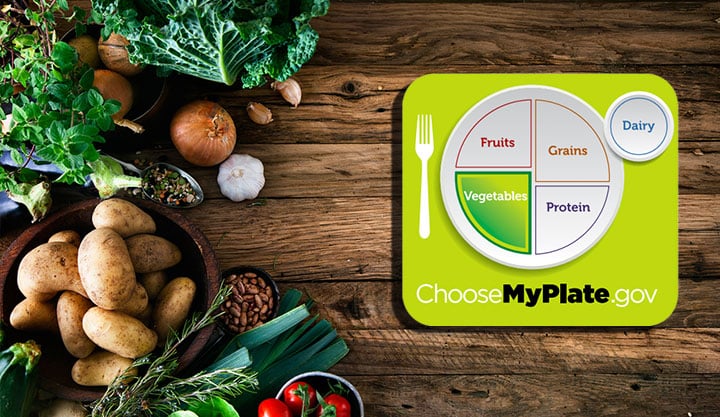Did you know that any vegetable or 100% vegetable juice counts as a member of the vegetable group? When choosing what to eat, keep in mind that vegetables may be raw or cooked; fresh, frozen, canned, or dried/dehydrated; and may be whole, cut-up, or mashed. Women should get 2-2.5 cups of vegetables in per day. While men should consume 2-3 cups per day.
Eating a diet rich in vegetables and fruits as part of an overall healthy diet may reduce risk for heart disease, including heart attack and stroke. That is why including vegetables in your balanced diet is so important!
What Is A Serving of Vegetables?
In general, 1 cup of raw or cooked vegetables or vegetable juice, or 2 cups of raw leafy greens can be considered as 1 cup from the vegetable group.
Dark-Green Vegetables
- arugula (rocket)
- bok choy
- broccoli
- broccoli rabe (rapini)
- broccolini
- collard greens
- dark-green leafy lettuce
- endive
- escarole
- kale
- mesclun
- mixed greens
- mustard greens
- romaine lettuce
- spinach
- Swiss chard
- turnip greens
- watercress
Red and Orange Vegetables
- acorn squash
- bell peppers
- butternut squash
- carrots
- pumpkin
- red chili peppers
- red peppers, sweet
- sweet potatoes
- tomatoes
- 100% vegetable juice
Starchy Vegetables
- corn
- green bananas
- green lima beans
- green peas
- parsnips
- plantains
- potatoes, white
- taro
- water chestnuts
- yams
Beans and Peas*
- bean burger
- black beans
- black-eyed peas (mature, dry)
- chickpeas (garbanzo beans)
- edamame (young soybeans)
- falafel (spiced, mashed chickpeas)
- fava beans (broad beans)
- hummus (chickpea spread)
- kidney beans
- lentils
- lima beans (mature)
- navy beans
- pinto beans
- soy beans
- split peas
- white beans
.
Other Vegetables
- alfalfa sprouts
- artichokes
- asparagus
- avocado
- bamboo shoots
- bean sprouts
- beets
- Brussels sprouts
- cabbage
- cauliflower
- celery
- cucumbers
- eggplant
- garlic
- green beans
- green peppers
- jicama
- leeks
- lettuce, iceberg
- mung bean sprouts
- mushrooms
- okra
- onions
- pattypan squash
- radicchio
- radishes
- red cabbage
- scallions
- snow peas
- tomatillos
- turnips
- wax beans
- yellow squash
- zucchini
Here are a few tips when choosing the best nutritional value for vegetables to eat!
- Select vegetables with more potassium often, such as sweet potatoes, white potatoes, white beans, tomato products (paste, sauce, and juice), beet greens, soybeans, lima beans, spinach, lentils, and kidney beans.
- Sauces or seasonings can add calories, saturated fat, and sodium to vegetables. Use the Nutrition Facts label to compare the calories and % Daily Value for saturated fat and sodium in plain and seasoned vegetables.
- Prepare more foods from fresh ingredients to lower sodium intake. Most sodium in the food supply comes from packaged or processed foods.
- Buy canned vegetables labeled “reduced sodium,” “low sodium,” or “no salt added.” If you want to add a little salt it will likely be less than the amount in the regular canned product.
Let the team at Mediplan Diet help guide you on your quest for healthy eating. Schedule an appointment today with one of our professionals to get started!

